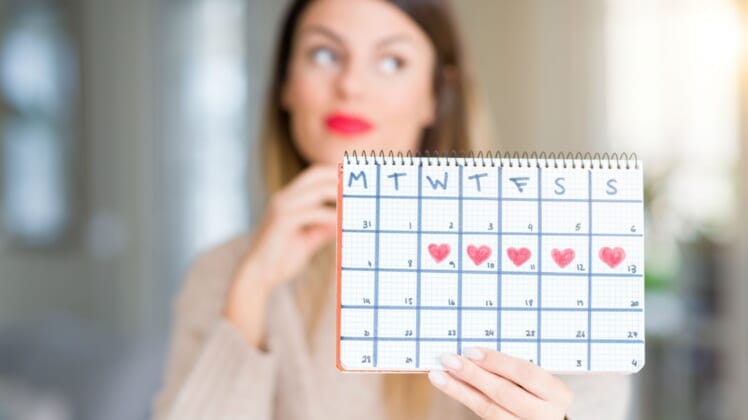
Most of us know Aunt Flo fairly well. She arrives every 21-35 days like clockwork and hangs out for 4-7 days before taking a 3-week hiatus until her next visit. But if you’re in your 30s, 40s or 50s, you may have noticed that your menstrual cycle is different than it was in younger years. There are several reasons for this, according to experts, and changes in your period are completely normal. To fully understand these changes, however, it’s important to know what’s happening in your body throughout your cycle.
What happens during the menstrual cycle?
In its most simplest essence, a period is shedding of the uterine lining. “During the first half of the menstrual cycle (days 0-14), your brain tells your ovaries to grow an egg that will be chosen to ovulate that month,” explains Anate Brauer, MD, reproductive endocrinologist and IVF director at Shady Grove Fertility in New York City. “As the egg grows, it matures and makes estrogen, which stimulates the lining of the uterus to thicken.”
Once this egg reaches its peak maturity, it ovulates, creating the other important female sex hormone, progesterone. As Dr. Brauer goes on to explain, progesterone prepares the lining of the uterus for implantation (aka fertilization), but if that doesn’t happen, progesterone drops and your body sheds the uterine lining to reset for the next cycle.
So why do periods change over time?
It’s not uncommon for menstrual cycles to be irregular during adolescence. In fact, it takes an average of 1-3 years for cycles to regulate and become ovulatory, according to Dr. Brauer. “By the late teens and into 20s, cycles should have a regular pattern, ranging form 21-35 days in length (period to period),” she says.
“Over time, however, as we lose eggs and our ‘ovarian reserve’ decreases, our brain starts working harder to grow an egg, resulting in a shorter first half of the menstrual cycle (from period to ovulation), which thus shortens the length of a cycle in total,” Dr. Brauer explains. For instance, a woman who might have had fairly regular cycles in her 30s may notice that her cycles are becoming closer together as she reaches her 40s. This shortening continues until cycles start dropping out entirely, also known as menopause.
Here’s a further look at how your period might change with age:
Teens
Most girls will start their period sometime between 11 to 14 years old, and they will typically experience irregular periods lasting a couple years after the menstrual cycle officially begins, notes Sherry A. Ross, MD, OBGYN in Santa Monica, CA, and author of she-ology. “It may take a few years for your period to become regular, but it ultimately will for the majority of young women,” she adds. This often coincides with the development of breasts and acne.
20s and 30s
After a highly hormonal period of puberty in your teens, your 20s are usually marred by some well-deserved regularity, and by your 30s, your period should become pretty predictable. Some women, however, still notice imbalances and irregularities, which are usually due to eating disorders, excessive exercise, or a number of conditions including thyroid disorders, endometriosis, and PCOS, notes Alyssa Dweck, MD, OBGYN in Westchester, NY. During these decades, bleeding may become lighter or heavier, and you may also start experiencing worsened PMS, cramps, and breast tenderness.
40s
Perimenopause sets in during your 40s, bringing about a myriad of hormonal variations that can make your period erratic and irregular, notes Dr. Ross. “Perimenopause happens when your ovaries cease to function consistently, thereby upsetting your normal hormonal rhythm,” she says. “The erratic and disruptive symptoms of perimenopause tend to mark the beginning of menopause.” These symptoms often include missed or unpredictable periods, a heavier flow, spotting, and longer stretches of PMS.
50s
Menopause occurs on average around age 51 for most women, but symptoms, ranging from hot flashes and sweating to fatigue, and poor concentration, can begin up to 10 years earlier. “When a woman does not have a period for one year she is most likely in menopause suggesting that the ovaries have stopped producing estrogen permanently,” says Dr. Ross. “Some say menopause is puberty in reverse—it’s basically a second puberty for women as hormones significantly impact a woman’s life and those around her.”
While these are common changes for most women, they are not true for everyone. If you find that your periods are becoming more irregular or painful for unknown reasons, reach out to your primary care doc or gynecologist who can run some tests and get you some answers.
You might also like: 7 Period Myths You Need To Stop Believing Already
